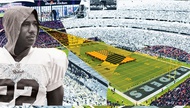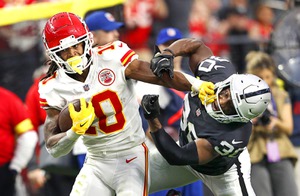Hope was short lived for Raiders fans in 2004. In the third game of the year, with the Tampa Bay Buccaneers visiting Oakland Coliseum, Raiders quarterback Rich Gannon was leveled by Derrick Brooks in the first quarter. He walked off the field, but was out for the game. Later, it would be revealed he broke a vertebrae and his career was effectively over. As Gannon left the field and backup Kerry Collins jogged in, the stadium collectively sighed as if to say, “There goes another season.” It was my first Raiders game in person, and, given the common stereotypes of the fans, I half expected a riot to break out. A fan a row in front of me slumped his shoulders: “Well, sh*t!” he spat. Then he sparked a joint and passed it around.
After three straight playoff seasons from 2000-2002, the Raiders were now in year two of what would become a string of 13 consecutive seasons where they failed to post a winning record. Yet one of the most famous fan groups in the world, Raider Nation, continued to fill the Black Hole and the rest of the Coliseum during the lean years. The well-known passion, and copious amounts of black face paint, never waned. Finally, in 2016 the team showed promise, with a cast of young, talented players led by quarterback Derek Carr and linebacker Khalil Mack, finishing the year 12-4. Just in time to announce a move to Las Vegas.
*****
That $750 million from Nevada state coffers buys a shiny, new domed stadium, and entry into the ultra-exclusive club known as the National Football League — all things that boosters of the move cheered when the decision was finalized on March 27. It also buys Las Vegas membership into Raider Nation—and all of the perceptions, good and bad, that go along with the diehard, black-and-silver-clad fanbase.
Not everyone in the Vegas Valley was pleased that the NFL team that chose Las Vegas as its new sugar daddy was the Raiders, linked for decades to gangs, violence and all-around bad behavior. Like the fans watching Rich Gannon gingerly walk off the Coliseum field that day in 2004, Las Vegas is now waiting to see what happens next.
Dating back to the team’s time in Los Angeles from 1982-’94, when rap group N.W.A. soared to stardom while wearing Raider gear and the logo became increasingly affiliated with gangs, the fanbase has been labeled as miscreants.
When the move to Las Vegas was announced, the comments sections of news stories were littered with “derelicts,” “thugs,” “criminals” and other epithets for Raiders fans. The parody website SportsPickle ran the headline: “California Parole Board rules Raiders fans may not cross state lines to go to games in Las Vegas.” Would every Raiders home game be a rerun of the 2007 NBA All-Star weekend, which was marked by a crime spike and roughly 300 arrests?
The persistent prejudice toward Raiders fans is nothing new to Rob Rivera, president of the Black Hole fan association out of Oakland. Asked how he’s doing a week after the move became official, he grumbles, “Surviving.” He and his fellow Raiders faithful are still navigating their reaction and feelings about the team’s relocation.
“It’s very unfortunate that the decision was made to leave such a loyal fanbase that is passionate and one of a kind,” he said. “This fanbase saw them through some difficult times, and the team is going to lose its soul. I’m sure there are good Raiders fans in Vegas, but I’m also sure the culture in Oakland can’t be duplicated.”
Las Vegas Weekly Raider Nation Cover Shoot - from YouTube.com
Rivera acknowledged the long-held ruffian reputation of Raiders fans, but argued that it’s more myth than reality.
“Unfortunately, over the years the Raider Nation has gotten an extremely bad rap,” he said. “There was a time almost 20 years ago when they first returned to the Oakland Coliseum that it was a rough place. But over the years that has subsided, and a lot of the Raider Nation are made up of really good people. Obviously there is a bad element to every fanbase, from San Francisco to Arizona to Philadelphia. Every fanbase has its issues with unruly fans.”
Perception vs. reality
At times, it seems the Raiders franchise embraced, even celebrated, the bad guy image. Al Davis, the team’s famous owner who died in 2011, cultivated a renegade image. Davis introduced the silver and black color scheme to the team, openly defied league conventions at every turn and sued the NFL on multiple occasions. Between the 2006-2016 NFL seasons, the Oakland Raiders led the league in penalties three times and were ranked in the top five in five other years.
“History will dictate what my legacy is,” Davis once said. “[You] do it your way, don’t let the culture tell you what to do. That’s being a Raider.”
While Al Davis was suing the league, moving the team multiple times and otherwise perpetuating the dissident nature of his franchise, he was also one of football’s most progressive owners. In the ’60s, Davis refused to let his team play in cities where black and white players couldn’t stay in the same hotels, and he was the first NFL owner to hire an African American head coach and a female chief executive.
“What strikes people is that the Raider fan demographic is more brown and black skin, a more minority following than any other fanbase, and I think that scares people,” Rivera said.
“You know what else scares people? When you have a number of big, burly, heavy-set fans with beards and goatees that are passionate. That can be taken the wrong way.”
What do the actual numbers say? Last year the Washington Post looked at arrests made during NFL games within the stadiums and in the surrounding neighborhoods. The results are, in a word, mixed. While Raiders fans are often seen as the baddest in the lot, it was the Chargers, then of sunny San Diego where everyone is tan and pleasant, who led the league in arrests per game at an average of 24.6. They were followed by two teams who share a stadium, the Giants (22.5) and Jets (21.5), with the Raiders coming in fourth (17.8) and Steelers (16.8) in fifth. The 49ers, across the bay, were also in the top half of the league with an average 11.4 arrests per game.
Certainly, there are plenty of news reports of Raiders fans acting violently, but the same can be said about other teams’ fans. In 2015 a man was shot and killed outside a Dallas Cowboys game at AT&T Stadium. In 2014 a man at the 49ers home field, Levi’s Stadium in Santa Clara, California, was beaten so badly he now suffers from seizures. The year before that, a 30-year-old man was attacked in the parking lot of Kansas City’s Arrowhead Stadium and beaten to death.
The Washington Post data did find some evidence that trouble may follow Raiders fans. Arrests at stadiums hosting Raiders away games rise by an average of 70 percent, the highest in the league for road teams. Still, a visit from the Steelers, Eagles or 49ers also tends to boost the number of arrests.
Fans, like any other
Richard Cervera, 48, has been a Raiders fan since he was nine years old. He grew up in Los Angeles where his uncle took him to his first Raiders game. When the team returned to Oakland in 1995, Cervera was hurt but kept on rooting.
“With Raiders fans there is no second team,” he said. “You only have one team.”
Now, 22 years later, Cervera is one of the organizers of the Las Vegas Raider Nation fan group and has the good fortune of his lifelong team moving to him. At first he was against the transfer and the team leaving behind the loyal fans in Oakland. Now with the deal done, he can’t contain his excitement.
“I get goosebumps just talking about it,” he said. “It’s like my family is moving to be close to me. I feel like it’s a family reunion.”
His wife and four children are Raiders fans, and he travels to two or three games every season. He says he has never felt unsafe at a Raiders game, and the fans are largely misunderstood.
“I don’t think the reputation is deserved, and it is definitely outdated at this point,” Cervera said. “Any gang will have an affiliation with some team, or wear some clothing. Gangs in Dallas wear Cowboys stuff. I think because of the time when it happened, with rap blowing up and N.W.A. wearing all this Raider gear, it became really high profile. So people made that affiliation. But if it had been some rap group from some other city, wearing some other team’s gear, everyone would say that team’s fans are all gang members.”
Indeed, some of the Raider Nation image was built on timing, chance and opportunity. In 1980, the LA Rams moved from the Los Angeles Coliseum to Anaheim. In Ice Cube’s film on the convergence of N.W.A. and the Raiders, 30 for 30: Straight Outta LA, he says they went “as far as they could from any black fans.” Los Angeles was ready for a new team, something to support. The color scheme and pirate aesthetic didn’t hurt, either.
“Purple and gold,” says N.W.A.’s MC Ren in Straight Outta LA, “I don’t think that would have looked good on us.”
*****
The Black Hole’s Rob Rivera is still coping with the loss of his team, but he hopes that the city lucky enough to get the Raiders doesn’t buy into the negative stereotypes.
“The Black Hole fan organization is made up of a wide range of folks,” he said. “We have average Joes that work in warehouses to executives at Chevron. We have professionals, famous musicians and ex-players. There are lawyers, doctors … We have every age group and industry covered. No fanbase should be painted with a broad brush, and Raider Nation is no different.”
It was more than 20 years ago when the Raiders came to represent gang culture and violence, and that image seems more obsolete with each passing year. Now, presumably, Raider Nation will include more dealers, valets, showgirls and cocktail waitresses. The next chapter of the franchise will be written in Southern Nevada, and it’s up to us how it will read.



![“We were sitting there talking about aliens, and [Garoppolo] just sits down like, ‘What are you guys talking about? Aliens? Oh, I’ve got a couple thoughts.’”](http://media.lasvegasweekly.com/img/photos/2023/09/06/20230813_sun_RAIDERS_VS_49ERS_selects_WV_047_r190x108.png?865431e890af804dfed7ccab93b8b85c95853c35)




